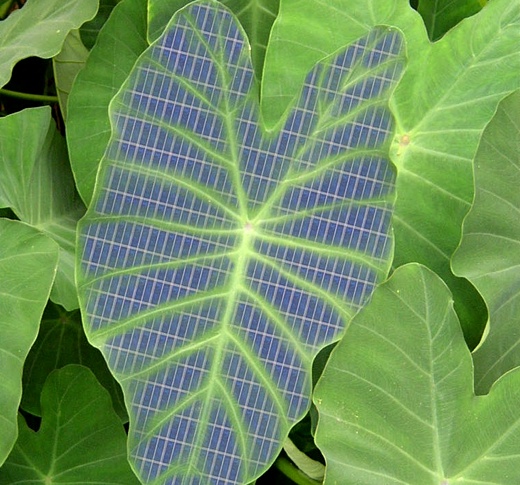By Brian Merchant on 17 August 2011 for TreeHugger -
(http://www.treehugger.com/files/2011/08/solar-cheap-coal-china-report.php)

Image above: Solar PV panels on taro leaf. From (http://hawaiisolar.blogsome.com/2009/06/16/hawaii-solar-energy-one-stop-source-for-complete-solar-hot-water-systems/).
If the government-linked reports are to be believed, then China's all set to double its solar capacity by the end of the year -- up to 2 Gigawatts, in fact. That was (somewhat) surprising news alone. But the solar industry is pointing out that buried in the same report was a projection that solar power will be as cheap as -- or cheaper than -- coal in less than five years.
Reuters reports on the part of the study that has the solar world talking:
The solar feed-in tariff, the price of solar-generated electricity, could drop below 0.80 yuan (12.5 cents) for each kilowatt-hour (kWh) by 2015, which would be on par with conventional coal-fired power tariffs by that time, according to s report by the Energy Research Institute, led by the National Development and Reform Commission (NDRC).The optimistic finding has the solar industry buzzing. This morning, the Solar Trade Association sent out a notice stating harping on the Chinese report. Its chairman, Howard Johns, said in a statement that the "news that Chinese researchers anticipate solar could be as cheap as coal power by 2015 follows many reports this year predicting solar is set to achieve a major cost breakthrough with sustained investment today."
The finding is pretty consistent with other reports that predict solar will hit parity with coal by the end of the decade.
STA used the news to urge the UK to move faster in adopting solar. Johns noted that, "Clearly some people in China believe solar could be cheaper than coal by the end of this Parliament. This is not a technology anyone can afford to ignore, particularly given the UK does have some major manufacturing opportunities. Solar technology has the potential to readily generate 30% of the UK's electricity needs, and create hundreds of thousands of new jobs."
Cheaper Solar Panels
SUBHEAD: First Solar's cadmium telluride breakthrough could make PV cheaper than coal.
By Christine Lepisto on 10 August 2011 for TreeHugger -
(http://www.treehugger.com/files/2008/08/cheaper-solar-panels-first-solar.php)
The quest for inexpensive solar panels continues, with cadmium telluride generating enthusiasm among investors and hopeful followers of the advance of alternative energy technologies. Over at IEEE Spectrum, Richard Stevenson speculates that First Solar might beat over 80 competitors to achieve manufacturing costs low enough to market solar panels at less than $1 per Watt, the target considered necessary for solar to compete with coal-burning electricity on the grid. Tempe, Arizona, based First Solar's main market currently is Germany, where government policies promote solar power growth.
Cadmium Advantages in Solar Panels With silicon supplies under pressure after rocketship market growth, alternative photovoltaic technologies can wedge into the competition. Cadmium has several advantages over traditional silicon technology. These include:
- The necessary electric field, which makes turning solar energy into electricity possible, stems from properties of two types of cadmium molecules, cadmium sulfide and cadmium telluride. This means a simple mixture of molecules achieves the required properties, simplifying manufacturing compared to the multi-step process of joining two different types of doped silicon in a silicon solar panel.
- Cadmium telluride absorbs sunlight at close to the ideal wavelength, capturing energy at shorter wavelengths than is possible with silicon panels
- Cadmium is abundant, produced as a by-product of other important industrial metals such as zinc.
Environmental Issues of Cadmium Concerns that risks of cadmium telluride in solar photovoltaic film have been raised. TreeHugger Forums commenter green Wind Power Fan makes reference to an article noting that few manufacturers are producing cadmium telluride solar panels which pass the US EPA's leaching test, a process used to determine whether toxic metals, such as cadmium, might seep out into groundwater from improperly disposed waste.
But solar panels have relatively long lifespans, measured in decades. This means that laws like the European ban on cadmium in electronic gadgets are less necessary, because the benefits of a long lifespan outweigh the managed risks of using cadmium telluride. Furthermore, recycling at end of life will minimize risks. First Solar already plans for the take-back of solar panels they sell today, after a 25 year lifespan.
See also:
Ea O Ka Aina: Cheap Full Spectrum Solar PV 6/17/11
Ea O Ka Aina: Solar PV to be cheaper than diesel 5/26/11
.
No comments :
Post a Comment